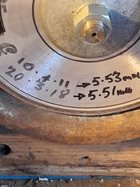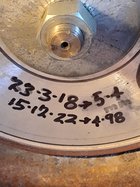odie
TOTW Team
- Joined
- Dec 22, 2006
- Messages
- 7,123
- Likes
- 9,883
It appears as though, given a choice between cbn and diamond, the diamond abrasive would be the better choice.....within certain limitations. @Randy Heinemann 's observation of the heat reaction of diamond while grinding HSS is a consideration that would seem to make cbn a better choice for a high speed application.
I had thought of the cbn honing possibility, but that appears to be a waste of money.
This is relevant:
"Both diamond and CBN are almost equal, with about four times the abrasion resistance of Al-oxide. However, while CBN is substantially harder than other conventional abrasives, it has only 64 percent the hardness of diamond"
-----odie-----
I had thought of the cbn honing possibility, but that appears to be a waste of money.
This is relevant:
"Both diamond and CBN are almost equal, with about four times the abrasion resistance of Al-oxide. However, while CBN is substantially harder than other conventional abrasives, it has only 64 percent the hardness of diamond"
-----odie-----


